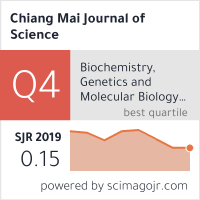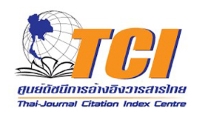JOURNAL DETAIL
Seasonal Variation and Sources Estimation of PM2.5-Bound PAHs from the Ambient Air of Chiang Mai City: An All-year-round Study in 2017
Paper Type |
Contributed Paper |
Title |
Seasonal Variation and Sources Estimation of PM2.5-Bound PAHs from the Ambient Air of Chiang Mai City: An All-year-round Study in 2017 |
Author |
Sawaeng Kawichai, Tippawan Prapamontol, Somporn Chantara, Tinakorn Kanyanee, Wan Wiriya and Yan - Lin Zhang |
Email |
tprapamontol@gmail.com; tippawan.prapamontol@cmu.ac.th; dryanlinzhang@outlook.com |
|
Abstract: This study investigated PM2.5-bound polycyclic aromatic hydrocarbons (PAHs) concentration to estimate sources of air pollution in Chiang Mai City, Thailand. In this study, the ambient PM2.5 samples were collected from January to December 2017 in Chiang Mai City (18° 47′ N, 98° 57′ E). Sixteen PAHs that have been designated as high priority by the US EPA were analyzed using a gas chromatograph (Model 7890A, Agilent) equipped with a mass spectrometer detector (Model 5975C). The PM2.5 concentrations could be classified into two periods by using active fire data (or so-called number of hotspots) detected by Moderate Resolution Imaging Spectroradiometer, a type of remote satellite sensing imaging. The first period took place from January to May, as a result of high biomass burning (HBB; n=62) and the second period occurred from June to December due to low biomass burning (LBB; n = 58). In both periods there was a significant difference between the 24-hour mean concentrations of PM2.5 ranging from 6.07 - 79.9 μg/m3 with a mean±SD of 35.8±16.3 μg/m3 for the HBB period and 7.71 - 53.4 μg/m3 with a mean±SD of 24.6±10.4 μg/m3 for the LBB period. Meanwhile, the mean concentrations of the 16 PAHs in the HBB period were significantly higher than those in the LBB period (p<0.01). The mean concentration of total PAHs in the HBB period was 9.22±3.11 ng/m3 as compared to 3.51±1.85 ng/m3 in the LBB period. The mean concentration of tPAHs in the HBB period was significantly higher than those in the LBB period (p<0.01). Molecular diagnostic ratios and principle component analysis of individual detected PAHs were used to characterize and identify their possible sources. The results indicated that biomass burning was the primary source of PAHs in the HBB period while fuel combustion and biomass burning were the sources in the LBB period. The present study results therefore suggest that a year-round study was able to estimate the sources of PM2.5-bound PAHs from the ambient air of Chiang Mai City. |
|
Start & End Page |
958 - 972 |
Received Date |
2020-03-13 |
Revised Date |
2020-05-06 |
Accepted Date |
2020-05-22 |
Full Text |
Download |
Keyword |
air pollution, PM2.5, PAHs, biomass burning |
Volume |
Vol.47 No.5 (September 2020) |
DOI |
|
Citation |
Kawichai S., Prapamontol T., Chantara S., Kanyanee T., Wiriya W. and Zhang Y.-.L., Seasonal Variation and Sources Estimation of PM2.5-Bound PAHs from the Ambient Air of Chiang Mai City: An All-year-round Study in 2017, Chiang Mai Journal of Science, 2020; 47(5): 958-972. |
| View:1,199 Download:657 | |
RELATED ARTICLE
Air Quality Characteristics and Their Natural and Socioeconomic Drivers in Beijing-Tianjin-Hebei Economic Zone, Northern China
page: 1509 - 1529
Author:Xiaoxue Zhang, Shuang Li and Chengcheng Xia
Vol.49 No.6 (November 2022) View: 2,119 Download:616
page: 1509 - 1529
Author:Xiaoxue Zhang, Shuang Li and Chengcheng Xia
Vol.49 No.6 (November 2022) View: 2,119 Download:616
The Numerical Visualization of Air Pollution Propagation from a Single Generator to an Observed Area
page: 1430 - 1443
Author:Udomsak Rakwongwan, Arnon Archankul, Sanae Rujivan and Perter Bastian
Vol.48 No.5 (September 2021) View: 1,558 Download:406
page: 1430 - 1443
Author:Udomsak Rakwongwan, Arnon Archankul, Sanae Rujivan and Perter Bastian
Vol.48 No.5 (September 2021) View: 1,558 Download:406
Vector Autoregressive Model: A Multivariate Time Series to Forecast the Ground Level Ozone (O3) Concentration in Malaysia
page: 1297 - 1309
Author:Ahmad Fauzi Raffee, Hazrul Abdul Hamid*, Siti Nazahiyah Rahmat and Muhammad Ismail Jaffar
Vol.47 No.6 (November 2020) View: 1,038 Download:397
page: 1297 - 1309
Author:Ahmad Fauzi Raffee, Hazrul Abdul Hamid*, Siti Nazahiyah Rahmat and Muhammad Ismail Jaffar
Vol.47 No.6 (November 2020) View: 1,038 Download:397
Observations of Cloud Condensation Nuclei (CCN) in Northern Thailand
page: 767 - 776
Author:Thitikorn Chanyatham*, Pakdee Chantraket and Nuenghatai Tantiplubthong
Vol.43 No.4 (JULY 2016) View: 1,384 Download:356
page: 767 - 776
Author:Thitikorn Chanyatham*, Pakdee Chantraket and Nuenghatai Tantiplubthong
Vol.43 No.4 (JULY 2016) View: 1,384 Download:356
Phenanthrene Biodegradation by Pseudomonas sp. CH3 Isolated from Oil-contaminated Soil
page: 850 - 856
Author:Chetsada Pothiratana, Thanabhorn Jitthanasuwan, Jirayut Ratchawong and Surachai Thac
Vol.42 No.4 (OCTOBER 2015) View: 870 Download:312
page: 850 - 856
Author:Chetsada Pothiratana, Thanabhorn Jitthanasuwan, Jirayut Ratchawong and Surachai Thac
Vol.42 No.4 (OCTOBER 2015) View: 870 Download:312
Efficiency of a Tailor Made NO2 Passive Sampler and Correlations of NO2, PM10 and PM10 - bound NO3- in Urban Air of Chiang Mai (Thailand)
page: 386 - 400
Author:Chanakarn Khamkaew [a] and Somporn Chantara*[a,b]
Vol.40 No.3 (JULY 2013) View: 971 Download:292
page: 386 - 400
Author:Chanakarn Khamkaew [a] and Somporn Chantara*[a,b]
Vol.40 No.3 (JULY 2013) View: 971 Download:292
Indoor and Outdoor Levels of PM2.5 from Selected
Residential and Workplace Buildings in Chiang Mai
page: 219 - 226
Author:Narongpan Chunram, Usanee Vinitketkumnuen, Richard L. Deming, and Somporn Chantara
Vol.34 No.2 (MAY 2007) View: 879 Download:376
page: 219 - 226
Author:Narongpan Chunram, Usanee Vinitketkumnuen, Richard L. Deming, and Somporn Chantara
Vol.34 No.2 (MAY 2007) View: 879 Download:376
Chemical Analysis of Airborne Particulates for Air
Pollutants in Chiang Mai and Lamphun Provinces,
Thailand
page: 123 - 135
Author:Somporn Chantara, Sunanta Wangkarn, Urai Tengcharoenkul, Walaya Sangchan and Mongkon Rayanakorn
Vol.36 No.2 (MAY 2009) View: 943 Download:269
page: 123 - 135
Author:Somporn Chantara, Sunanta Wangkarn, Urai Tengcharoenkul, Walaya Sangchan and Mongkon Rayanakorn
Vol.36 No.2 (MAY 2009) View: 943 Download:269
Mango Tree Bark as Bioindicator for Air Pollution Monitoring in Chiang Mai City
page: 183 - 188
Author:Palee Subsri* and Wanaruk Saipunkaew
Vol.29 No.3 (DECEMBER 2002) View: 956 Download:192
page: 183 - 188
Author:Palee Subsri* and Wanaruk Saipunkaew
Vol.29 No.3 (DECEMBER 2002) View: 956 Download:192
Copyrights © Since 2021 All Rights Reserved by Chiang Mai Journal of Science










